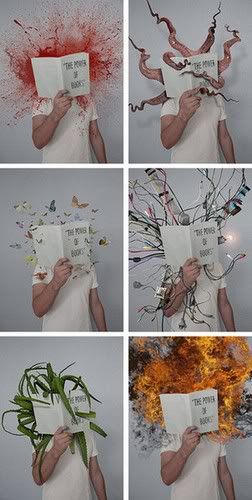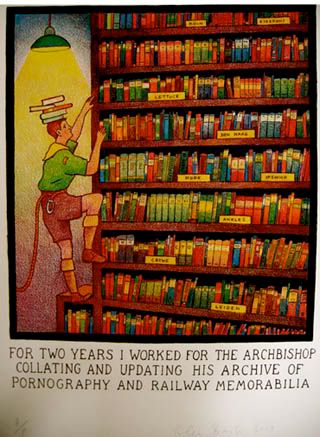 {image: The Power of Books, by Bulgarian artist Mladen Penev}
{image: The Power of Books, by Bulgarian artist Mladen Penev} 10. Beautiful Evidence by Edward Tufte As you may have noticed, I, like many scientists interested in communicating results effectively and/or graphic design, am a fan of Prof. Tufte. He has created his own tiny self-publishing empire, filled with beautiful books explaining how to use words and images together to express ideas, convey data and results, show causal relations, avoid ambiguity, and foster deep -honest- analysis, with elegance and beauty. His books are something which should be on the shelf of any professional who uses graphic information - not just the scientists, but the social scientists, journalists, and in fact, I think the artists would appreciate much of this work as well. For instance, he draws his indeed beautiful examples from scientific classics, like the notebooks of Galileo, but he's as likely to use Leonardo da Vinci or Albrect Dürer. Arguments about time series analysis are made with allusions to an 18th century treatise on the choreography of the contredanse. He discusses diagrammatic presentations of schools of 20th century art, maps of cubist paintings and debunks a therory of mystical geometries inherent in sculpture. He uses a French art nouveau ski manual and mid-20th century map of the area surrounding a Kyoto flower arranging school. Concepts from his other books reappear: 'sparklines' for concise communication of rich time series; the evils of 'chartjunk'; Minard's famous, and heart-wrenching flow map of the advance of Napoléon's dwindling army during the Russian campaign 1812-1813. I enjoyed his comparisons of Feynman diagrams, circuit diagrams and John Cage's musical scores. I, as you may have gathered, love the idea of combining text and image and delight in the reproductions of the Hypnerotomachia Poliphili, an illustrated manuscript from 1499 in Greek, Italian and Latin, shown side-by-side with an English translation. He praises Galileo, but also, is never afraid to re-draw diagrams to illustrate his theories and philosophy of clarity, succinctness and focus in displaying graphical information. He devotes an entire chapter to the evils of Powerpoint (basically, it seems that a culture of sloppy presentations and associated thinking within NASA killed seven astronauts) and another chapter to sculpture pedestals. There is nothing, it seems, which can be seen and which communicates that he would not take on as a cause - to make more elegant and more beautiful, and allow the evidence to speak for itself. This is definitely a book for any lover of art, science and books, like me.
11. Winter in July by Doris Lessing This is a series of short stories, originally published in 1966, set in Africa (presumably Rhodesia, at the time). These are stories of English people and cultural collisions with Boers, the group dynamics of ex-patriot communities, interactions between colonists and indigenous populations (and wildlife) and how even the well-meaning, kind-hearted people can see their relationships go horribly wrong, and surprisingly, a couple of stories of ménages à trois. Lessing is and has always been a keen observer of people.
12. Mr Tompkins in Paperback by George Gamow. George Gamow is one of the giants of 20th century nuclear and astro-physics and his Mr Tompkins is a classic of the popularization of physics (both relativity and quantum mechanics). Known for his humour, Gamow famously once wrote a paper with Ralph Alpher but convinced Hans Bethe to add his name to the author list during the revision process so the paper would be known as Alpher, Bethe and Gamow. See, Lady Redjeep, Classics jokes are common in physics, if not always sophisticated; what, after all, could be simpler than α, β, γ? Much of this book, parts of which were first written in 1938, and first published in this form in 1965, are now quite out-of-date. So, it is unlikely to be read by people who are not physicists or interested in the popularization of science. But, it has its charms. Mr Thompkins - even dimmer than than your usual 'Watson' - is a bank clerk who attends a physics lecture and dreams himself a world where relativistic physics is everyday (i.e. where the speed of light is very low, and length contraction and time dilation can be observed riding a bicycle). He continues to attend the Professor's lectures (ultimately falling for and marrying his daughter, an artist). He continues to fall asleep during lectures, and dream about other worlds, where, for instance Planck's constant is very large, and hence quantum effect are seen in billiard balls or even elephants. The stories are illustrated by John Hookham, and upon his retirement, Gamow himself. Gamow's illustrations are both amateurish, but delightfully naïve, and somewhat surreal (and remind me of a less proficient Glen Baxter - see figure below). There is even music - including a chapter detailing an opera about the Big Bang versus steady-state models of the universe with a libretto featuring 'characters' the Abbé Georges Lemaître, "a Russian physicist, George Gamow, who had been taking his vacation in the United States for the last three decades" (a wonderfully post-modern trick) and Fred Hoyle. The character "George Gamow" sings "Gaily and drunkenly"
Good Abbé, ourr underrstandink
It is same in many ways.
Univerrse has been expandink
Frrom the crradle of its days.
Univerrse has been expandink
Frrom the crradle of its days.
...
 and so forth. Clearly, this is a man with a sense of humour about himself. My favorite, the suave Maxwell's Demon, makes an appearance. The way he wrote his own colleagues and contemporaries into a sort of fairytale - and illustrated them too - is sort of hilarious, to the physicist. Though some cultural and gender biases, as well as particle physics from just before the conceptualization of the quark, now seem quite dated.
and so forth. Clearly, this is a man with a sense of humour about himself. My favorite, the suave Maxwell's Demon, makes an appearance. The way he wrote his own colleagues and contemporaries into a sort of fairytale - and illustrated them too - is sort of hilarious, to the physicist. Though some cultural and gender biases, as well as particle physics from just before the conceptualization of the quark, now seem quite dated. If you would like a similar sort of approach, with more up-to-date information, you might like the Alice in Quantum Land by Robert Gilmore.
{Series so far: books read, more books read, books read, books read continues, more books read, I, II, III, IV, V, VI, VII, VIII, IX, X, XI, XII, XIII, XIV, XV, XVI, XVII, XVIII,XIX, XX, XXI, XXII, XXIII XXIV, XXV, XXVI, XXVII, XXVIII, XXIX, XXX, XXXI, XXXII}
______________________________________
On the subject of books, Faunalia suggested I try to find The Artist's Way in the used book stores on Roncesvalles, so I go in search of The Artist's Way and yet come out with Salman Rushdie's Grimus, Salinger's Catcher in the Rye to re-read, Dawkin's The Oxford Book of Modern Science Writing and Saramago's Blindness. I think this says something about me.









No comments:
Post a Comment